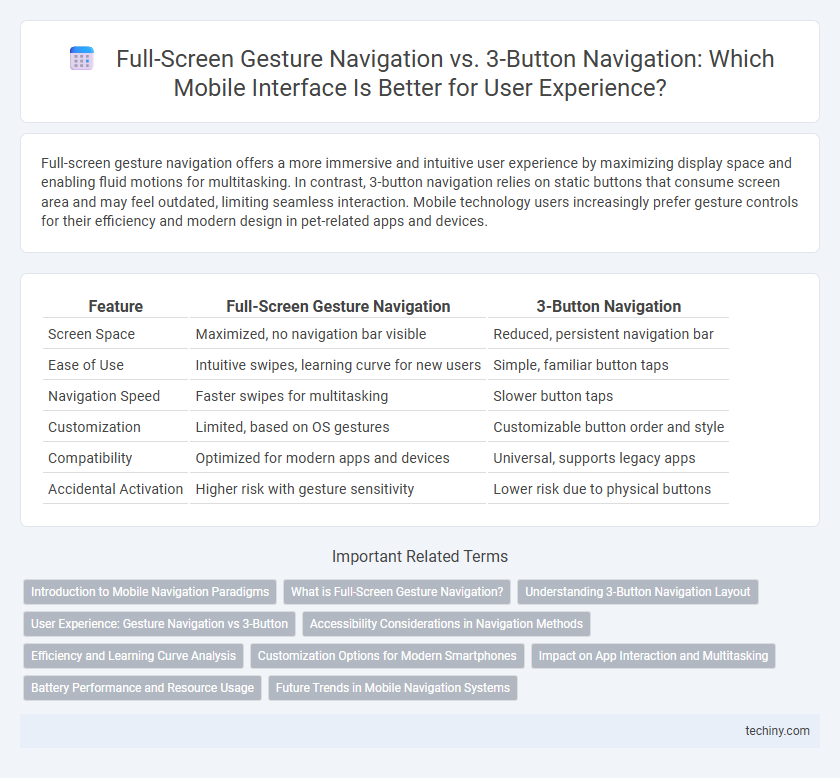Full-screen gesture navigation offers a more immersive and intuitive user experience by maximizing display space and enabling fluid motions for multitasking. In contrast, 3-button navigation relies on static buttons that consume screen area and may feel outdated, limiting seamless interaction. Mobile technology users increasingly prefer gesture controls for their efficiency and modern design in pet-related apps and devices.
Table of Comparison
| Feature | Full-Screen Gesture Navigation | 3-Button Navigation |
|---|---|---|
| Screen Space | Maximized, no navigation bar visible | Reduced, persistent navigation bar |
| Ease of Use | Intuitive swipes, learning curve for new users | Simple, familiar button taps |
| Navigation Speed | Faster swipes for multitasking | Slower button taps |
| Customization | Limited, based on OS gestures | Customizable button order and style |
| Compatibility | Optimized for modern apps and devices | Universal, supports legacy apps |
| Accidental Activation | Higher risk with gesture sensitivity | Lower risk due to physical buttons |
Introduction to Mobile Navigation Paradigms
Full-screen gesture navigation revolutionizes mobile interaction by replacing traditional 3-button setups with intuitive swipes, enhancing screen real estate and user immersion. Gesture navigation supports natural fluidity, enabling faster app switching, multitasking, and customizable shortcuts without cluttering the interface. In contrast, 3-button navigation relies on fixed, visible controls that can limit display space and reduce interaction efficiency on modern smartphones.
What is Full-Screen Gesture Navigation?
Full-screen gesture navigation is a mobile interface method that replaces traditional buttons with swipe gestures, enabling users to navigate apps and system functions intuitively. This technology enhances screen real estate by eliminating the on-screen navigation bar, providing a more immersive experience on smartphones and tablets. Popularized by operating systems like Android 10 and iOS, full-screen gestures improve multitasking and accessibility through simple swipe actions.
Understanding 3-Button Navigation Layout
The 3-button navigation layout consists of three distinct icons: Back, Home, and Recent Apps, positioned at the bottom of the screen to provide straightforward access to essential functions. This traditional interface supports muscle memory and precise control, making it ideal for users transitioning from older smartphone models or those who prefer tactile feedback. Understanding this layout helps users efficiently multitask and navigate without relying on gesture sensitivity or screen edge swipes.
User Experience: Gesture Navigation vs 3-Button
Full-screen gesture navigation offers a more immersive user experience by maximizing screen real estate and enabling fluid, intuitive interactions compared to traditional 3-button navigation. Gesture controls reduce visual clutter and allow faster access to core functions, enhancing multitasking and app switching efficiency. However, 3-button navigation provides clear, consistent tactile feedback, appealing to users who prefer straightforward, reliable input methods.
Accessibility Considerations in Navigation Methods
Full-screen gesture navigation enhances screen space utilization but may pose challenges for users with motor impairments due to precise swipe requirements, impacting overall accessibility. In contrast, 3-button navigation provides tactile feedback and consistent button placement, facilitating ease of use for individuals with limited dexterity or cognitive impairments. Mobile technology developers prioritize inclusive design by integrating customizable navigation options, ensuring diverse user needs are accommodated for effective accessibility.
Efficiency and Learning Curve Analysis
Full-screen gesture navigation offers higher efficiency by maximizing screen real estate and enabling quicker access through intuitive swipes, reducing the time spent on app switching and multitasking. In contrast, 3-button navigation provides a simpler learning curve with explicit, familiar controls that benefit users less comfortable with gesture-based interfaces. Studies indicate that while gestures improve long-term usage speed, initial adoption may require more user training compared to the straightforward tap-based 3-button system.
Customization Options for Modern Smartphones
Full-screen gesture navigation offers enhanced customization options by allowing users to tailor swipe actions and gestures for app switching, home navigation, and multitasking, providing a more intuitive and immersive experience. In contrast, 3-button navigation provides limited personalization, typically confined to button order adjustments and basic functionality. Modern smartphones favor gesture navigation due to its flexibility in adapting to different user preferences and screen sizes, optimizing usability and aesthetic minimalism.
Impact on App Interaction and Multitasking
Full-screen gesture navigation enhances app interaction by providing a more immersive experience, allowing users to access content without visual interruptions caused by navigation bars. This system streamlines multitasking through intuitive swipe gestures that enable quick app switching and enhanced multitasking capabilities on modern smartphones. In contrast, 3-button navigation often segments screen space, potentially limiting seamless app interaction and slower multitasking transitions.
Battery Performance and Resource Usage
Full-screen gesture navigation improves battery performance by reducing the need for constant screen redraws linked to physical button usage, leading to lower power consumption. It also optimizes resource usage by minimizing background processes and allowing more efficient CPU allocation compared to 3-button navigation. Smartphones using gesture navigation typically achieve longer screen-on times and smoother multitasking due to these energy and resource savings.
Future Trends in Mobile Navigation Systems
Full-screen gesture navigation is increasingly favored for its immersive user experience and efficient screen usage, driven by advancements in AI-powered motion detection and haptic feedback technologies. Key trends indicate a shift towards customizable, context-aware gesture controls integrated with voice commands and augmented reality interfaces, enhancing accessibility and seamless interaction. Meanwhile, 3-button navigation is expected to phase out gradually as user demand for intuitive, minimalistic UI grows alongside innovations in mobile OS design such as Android 14 and iOS 18.
Full-Screen Gesture Navigation vs 3-Button Navigation Infographic

 techiny.com
techiny.com